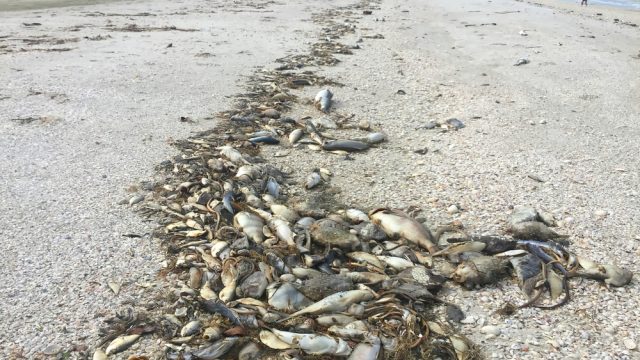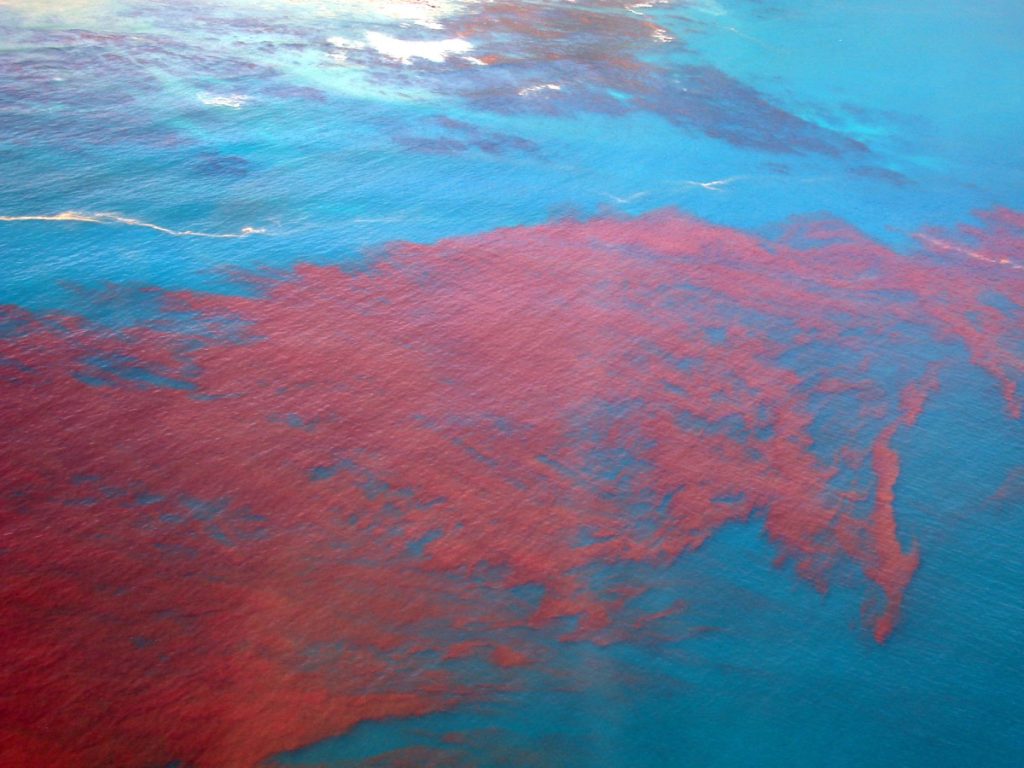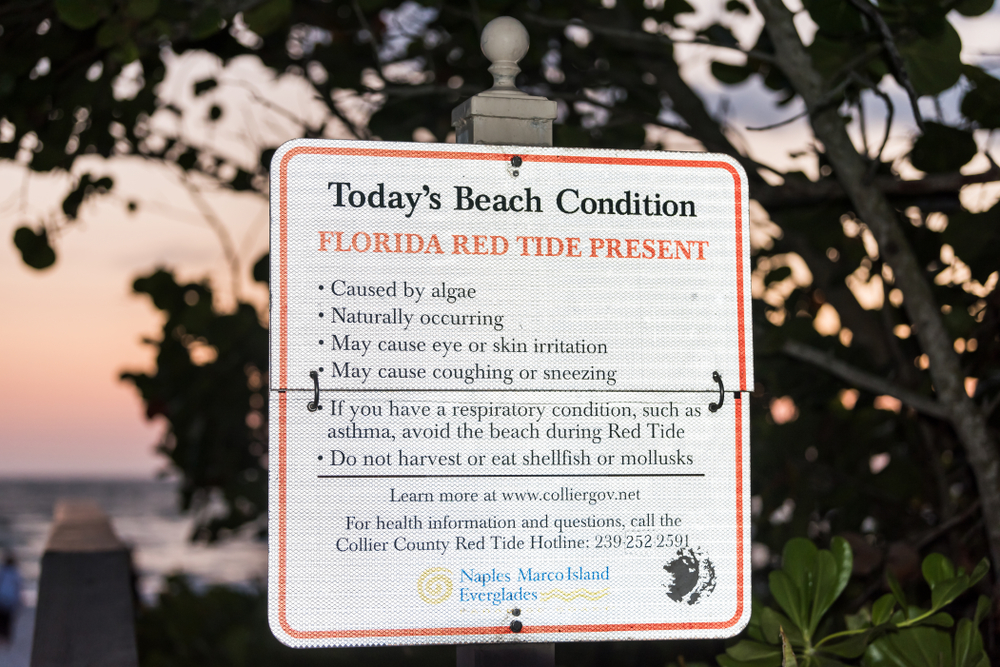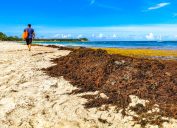Toxic "Red Tide" Algae Is Overwhelming U.S. Beaches: "You Can't Be Outside"
The natural event can cause respiratory problems in some people, even if you're not in the water.

Whether you're visiting on vacation or happen to live nearby, the beach can provide the perfect way to take in some fresh air and stay feeling refreshed in hot weather. However, the ocean itself can remain unpredictable, even during clear conditions. There is always the potential for a dangerous current or a towering wave to derail your attempt at taking a dip. And now, toxic "red tide" caused by algae is overwhelming some U.S. beaches just as temperatures are starting to rise. Read on to see how this could affect your next visit to the shore.
READ THIS NEXT: If You Notice This in a Hot Tub, Don't Go In, CDC Says.
Your next trip to the beach could be affected by toxic "red tide" blooms.

Most people look forward to the calming effects of a nice sea breeze when they make their way to the shore. Unfortunately, a natural event is making it harder for those spending their day on or near the water to get comfortable: Toxic "red tide" algae blooms are striking beaches along the Gulf Coast, USA Today reports.
In recent weeks, coastal areas of Southwest Florida have reported elevated levels of Karenia brevis (k. brevis) algae in the ocean. The single-cell microorganism has led to widespread fish kills and death of marine life as winds have shifted currents and pushed blooms toward coastlines. Areas from Tampa Bay running down through the Florida Keys have all reported moderate-to-high cell counts in water sampled by state officials.
While the Gulf Coast is no stranger to seasonal encounters with red tide, 2023 has been a particularly challenging year for those seeking to hit the beach. The state is currently experiencing an unusually large bloom brought on by heavy rainfall from Hurricane Ian that has spiked the algae's growth, National Geographic reports.
The algae can cause potentially severe symptoms in animals and humans.

Even though K. brevis occurs naturally in the ocean, algae blooms can often become a serious ecological issue during particularly bad years due to the brevotoxin released by the microorganism as a defense mechanism. Similar to the fish kills reported this year, a surge in 2018 along the Florida Gulf Coast led to the deaths of scores of marine wildlife, including manatee, Goliath grouper, sea turtles, and shore birds, USA Today reports.
However, humans also feel the effects during a particularly bad bloom. Winds can carry the toxin from the water and toward inland areas of the coast, creating respiratory problems such as wheezing and coughing, as well as sore throats and burning eyes. This can be especially problematic for people with asthma or other breathing problems, and can also pose a serious health threat to pets that swim in blooms or eat affected fish, according to the Florida Department of Health.
Some who live in areas along the coast have noted a change in the regular occurrence. "In high school, late '80s, I used to go out surfing, and you know, we didn't really understand it back then we just were getting choked by, you know, an algae bloom. Now, really, the algae blooms are just so much more pervasive. They've come into the back, the back waterways and different things, and they stay much longer," Toby Delbridge, a resident of Charlotte County in Florida, told local public radio affiliate WGCU.
"When you open your door and red tide is terrible outside. I mean it's—you can't be outside," he said.
RELATED: For more up-to-date information, sign up for our daily newsletter.
Here's how red tide could affect your next beach trip.

Even though red tide typically begins to ease with the beginning of spring and remains at lower levels during the summer, the latest ongoing bloom is still having effects on coastal areas. State officials say that they provide regular testing to monitor conditions and to provide a clearer picture for residents and visitors ahead of time.
"This bloom is dynamic over the course of a day, and from day to day and week to week. We have seen conditions worsen and improve several times since it started and even over the course of the past few weeks," Kate Hubbard, PhD, director of the Center for Red Tide Research for the Florida Fish and Wildlife Conservation Commission (FWC), recently told Health. "We have several tools that are helpful for providing information about the current status given that conditions can shift rapidly."
If your next beach day trip or vacation happens to coincide with a red tide bloom, it's best to avoid swimming in the ocean as it can cause skin irritation, rashes, and burning eyes, according to the Florida Department of Health. Those with respiratory issues or who are sensitive to the toxic microorganism may want to avoid the coast entirely, and anyone who experiences lingering symptoms due to exposure should seek medical attention.
Algae blooms aren't the only natural phenomenon currently affecting Gulf Coast beaches.

Unfortunately, it's not just algae that beachgoers along the coast are contending with this year. Scientists are also warning that a gigantic blob of seaweed known as sargassum is expected to land on shores in the U.S. over the upcoming summer, The New York Times reported. Besides being unsightly or uncomfortable for swimmers, the growth also releases toxins as it decomposes in the water and on land, which can create respiratory issues similar to K. brevis.
While such growths are also an annual event, research has shown that this year's is already at record size before its expected landfall across Florida and other Gulf Coast beaches over the summer. "It's incredible," Brian LaPointe, a research professor at Florida Atlantic University's Harbor Branch Oceanographic Institute, told NBC News. "What we're seeing in the satellite imagery does not bode well for a clean beach year."
Besides ruining beach days, the seaweed can also create serious problems for residents by clogging waterways and jamming boat propellers. It can also create issues for marine life by depleting oxygen levels in the water, per The Times.





















